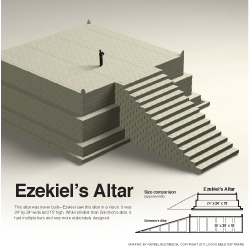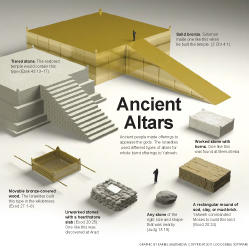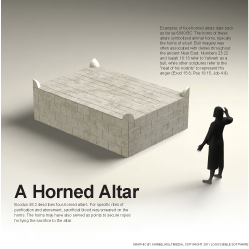43:1–12 Ezekiel’s guide returns him to the outer eastern gate of the temple, where the tour began, to witness Yahweh’s return to dwell in the temple. The scene is the reverse of 10:15–22, in which Yahweh’s chariot-throne departed through the east gate. Ezekiel now describes the return of Yahweh’s glory in much the same terms, emphasizing that what he sees is identical to the earlier visions (v. 3). After Yahweh returns, He declares to Ezekiel that He will remain there. He stresses the need for Israel to treat His name and His temple with proper respect and maintain the absolute holiness of the area. |
43:2 The glory of the God of Israel The visible presence of Yahweh (see note on Isa 6:3).
the sound of many waters See note on Ezek 1:24.
43:3 at his coming to destroy the city Alludes to Ezekiel’s earlier vision of the temple and city (see 9:3).
by the Kebar River Alludes to Ezekiel’s inaugural vision (see 1:1–3:15). On the Chebar (Kebar), see note on 1:1.
I fell on my face A typical response of reverence and fear. See note on 1:28.
43:5 the inner courtyard The Spirit moves Ezekiel from the outer gate to the inner court, closer to the temple where Yahweh’s presence has settled.
The glory of Yahweh filled the temple Compare 1 Kgs 8:10–11 when the divine presence entered Solomon’s temple. The language is similar in Isa 6:1 and Ezek 10:4.
43:6 someone speaking to me from the house Recalls Ezekiel’s inaugural vision (see 1:28). Similarly, Yahweh would speak with Moses from inside the tabernacle (see Exod 25:22).
43:7 I will dwell in the midst of the Israelites Fulfills the promise of Ezek 37:26–28.
43:8 placed their threshold with my threshold Refers to the mixed use of the earlier temple, where idol-worship was conducted side by side with sacrifices to Yahweh (see chs. 8–11).
their detestable things that they did The Hebrew word used here, to'evah, can refer to anything offensive. In this context, it refers to sacrilegious offenses. See note on 5:9.
43:11 all of its plans and all of Yahweh commands Ezekiel to pass on the design plan of the temple and all its new regulations to Israel to ensure they comply.
43:12 On the top of the mountain, all of its territory The most important requirement for Israel was to maintain the most-holy status of this temple area.
43:13–46:24 Ezekiel’s focus shifts to the rules and procedures regulating the activities of this new temple. Yahweh presents the laws to Ezekiel in a scene reminiscent of Moses at Sinai (compare Exod 19–24). Just as Moses received laws directly from Yahweh at His holy mountain, so Ezekiel receives a new set of laws directly from Yahweh at the top of the high mountain where the new temple is located. Ezekiel’s laws do not harmonize with the legal sections of the Pentateuch (the first five books of the Bible) because the new temple is accompanied by a new set of regulations. In general, the laws are directed at maintaining a greater level of sanctity and a stricter form of ritual purity than the laws in the Pentateuch. |
43:13–27 Ezekiel describes the altar for burnt offerings in the inner court of the temple. Its design is similar to the one built by Solomon (2 Chr 4:1); both are elevated, four-horned altars, but Solomon’s was solid bronze and larger than Ezekiel’s. The material of Ezekiel’s altar can be inferred as tiered stone, but the text does not explicitly discuss the composition of material, unlike the altar description in Exod 20:22–26. |
 Altars in the Old Testament Table
Altars in the Old Testament Table
43:18 the statutes of the altar After describing the altar, Ezekiel lays out instructions for purifying it before its initial use on behalf of the people. Seven days of sacrifices must take place before the altar is fully consecrated and purified for service.
43:19 the offspring of Zadok Zadok was the high priest under David. See note on Ezek 40:46.
43:20 the four horns of the altar Examples of four-horned stone altars have been unearthed in Palestine at Arad
at Arad and Beer-Sheba,
and Beer-Sheba, both from sites dating to the Israelite monarchy.
both from sites dating to the Israelite monarchy.

|
About Faithlife Study BibleFaithlife Study Bible (FSB) is your guide to the ancient world of the Old and New Testaments, with study notes and articles that draw from a wide range of academic research. FSB helps you learn how to think about interpretation methods and issues so that you can gain a deeper understanding of the text. |
| Copyright |
Copyright 2012 Logos Bible Software. |
| Support Info | fsb |
 Loading…
Loading…


